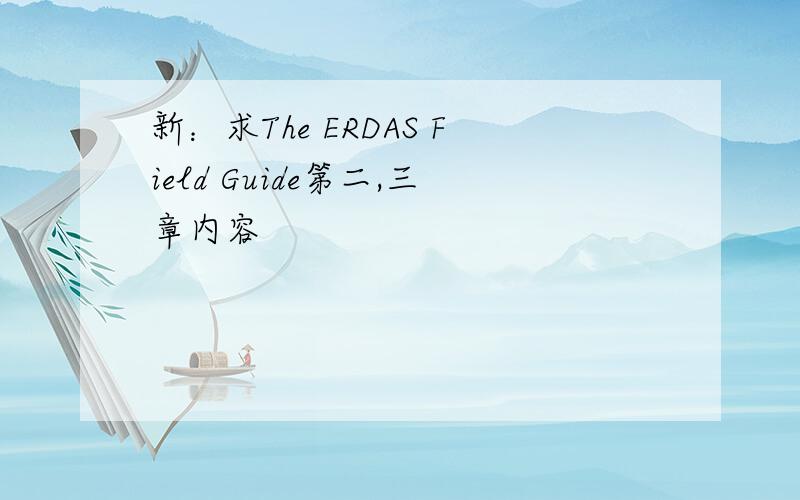新:求The ERDAS Field Guide第二,三章内容
来源:学生作业帮助网 编辑:作业帮 时间:2024/05/03 07:20:30

新:求The ERDAS Field Guide第二,三章内容
新:求The ERDAS Field Guide第二,三章内容
新:求The ERDAS Field Guide第二,三章内容
Chapter 2 Vector Layers
本章教学要求:有关专业英语单词
Introduction
ERDAS IMAGINE is designed to integrate two data types, raster and vector, into one system. The vector data structure in ERDAS IMAGINE is based on the ArcInfo data model (developed by ESRI, Inc. ). This chapter describes vector data, attribute information, and symbolization.
You can use ArcInfo coverages directly without importing them.
记住 Figure 2-1: Vector Elements 中的英文词.
ArcGIS Integration
ArcGIS Integration is the method you use to access the data in a geodatabase. ERDAS IMAGINE has always supported ESRI data formats such as coverages and shapefiles, and now, using ArcGIS Vector Integration, ERDAS IMAGINE can also access CAD and VPF data on the internet.
Chapter 3
Raster and Vector Data Sources
本章教学要求:1、重点:Satellite data部分
2其余部分,仅要求标题有关专业英语单词
Introduction
This chapter is an introduction to the most common raster and vector data types that can be used with the ERDAS IMAGINE software package.
The raster data types covered include: (See text,
Importing and Exporting(不用理会)
Satellite Data
There are several data acquisition options available including photography, aerial sensors, and sophisticated satellite scanners. However, a satellite system offers these advantages:
• Easily processed and analyzed by a computer.
• Many satellites orbit the Earth, so the same area can be covered on a regular basis for change detection.
• Once the satellite is launched, the cost for data acquisition is less than that for aircraft data.
• Satellites have very stable geometry, meaning that there is less chance for distortion or skew in the final image.
Satellite System
A satellite system is composed of a scanner with sensors and a satellite platform. The sensors are made up of detectors.
(See the detailed in text)
Satellite Characteristics
The U. S. Landsat and the French SPOT satellites are two important data acquisition satellites. They have several characteristics in common:
• Both scanners can produce nadir views.
• They have sun-synchronous orbits, meaning that they rotate around the Earth at the same rate as the Earth rotates on its axis, so data are always collected at the same local time of day over the same region.
• They both record electromagnetic radiation in one or more bands. Multiband data are referred to as multispectral imagery. Single band, or monochrome, imagery is called panchromatic.
Figure 3-1 Multispectral Imagery Comparison
IKONOS(was launched in September of 1999)
The resolution of the panchromatic sensor is 1 m. The resolution of the multispectral scanner is 4 m. The swath width is 13 km at nadir.
Table 3-4: IKONOS Bands and Wavelengths
补:美DigitalGlobel (EarthWatch)公司的QuickBird(快鸟)图像,波段分布与IKONOS同,但pan和multispectral分辨率分别达0.6和2.4米,为民用卫星之最.
IRS (Indian Remote Sensing Satellite)
Landsat 1-5 (See the histoty in text)
Landsats 1, 2, and 3 are no longer operating, but Landsats 4 and 5 are still in orbit gathering data.
Landsats 1, 2, and 3 gathered Multispectral Scanner (MSS) data and Landsats 4 and 5 collect MSS and TM data.
MSS (Multispectral Scanner)
MSS data are widely used for general geologic studies as well as vegetation inventories.
Table 3-8: MSS Bands and Wavelengths
TM (Thematic Mapper)
The TM scanner is a multispectral scanning system much like the MSS. TM has higher spatial, spectral, and radiometric resolution than MSS.
The spatial resolution of TM is 28.5 × 28.5 m for all bands except the thermal (band 6), which has a spatial resolution of 120 × 120 m.
Table 3-9: TM Bands and Wavelengths
Landsat 7
launched in 1999, uses Enhanced Thematic Mapper Plus (ETM+) to observe the Earth.
Table 3-10: Landsat 7 Characteristics
NLAPS
NOAA Polar Orbiter Data
AVHRR
See Table 3-11: AVHRR Bands and Wavelengths, also Figure 3-1.
OrbView-3 (US) 类似 IKONOS.
SeaWiFS(Sea-viewing Wide Field-of-View Sensor)
SPOT
The sensors operate in two modes, multispectral(20m) and panchromatic (10m).
Also see Figure 3-1.
Panchromatic
XS (see table 3-14: SPOT XS Bands and Wavelengths)
SPOT 4 (was launched in 1998)
增加一个1.58 to 1.75 μm的近红外波段;See table 3-15.
补:SPOT 5—— Panchromatic 波段达2.5米分辨率.
补:我国资源一号卫星CBERS
Radar Data
Researchers are finding that a combination of the characteristics of radar data and visible/infrared data is providing a more complete picture of the Earth. In the last decade, the importance and applications of radar have grown rapidly.
Advantages of Using Radar Data
• Radar microwaves can penetrate the atmosphere day or night under virtually all weather conditions. 全天候
• Under certain circumstances, radar can partially penetrate arid and hyperarid surfaces, revealing subsurface features of the Earth.
• For research on bodies of water.
Radar Sensors
Radar images are generated by two different types of sensors:
SLAR (Figure 3-4)
SAR — uses a side-looking, fixed antenna to create a synthetic aperture.
Active and Passive Sensors
An active radar sensor gives off a burst of coherent radiation that reflects from the target, unlike a passive microwave sensor which simply receives the low-level radiation naturally emitted by targets.
Applications for Radar Data
• Geology
• Classification
• Glaciology
• Oceanography
• Hydrology
• Ship monitoring
• Offshore oil activities
• Pollution monitoring
Image Data from Aircraft
This is useful if there is not time to wait for the next satellite to pass over a particular area, or if it is necessary to achieve a specific spatial or spectral resolution that cannot be attained with satellite sensors
http://www.erdas.com/Resources/ERDASFieldGuide.aspx